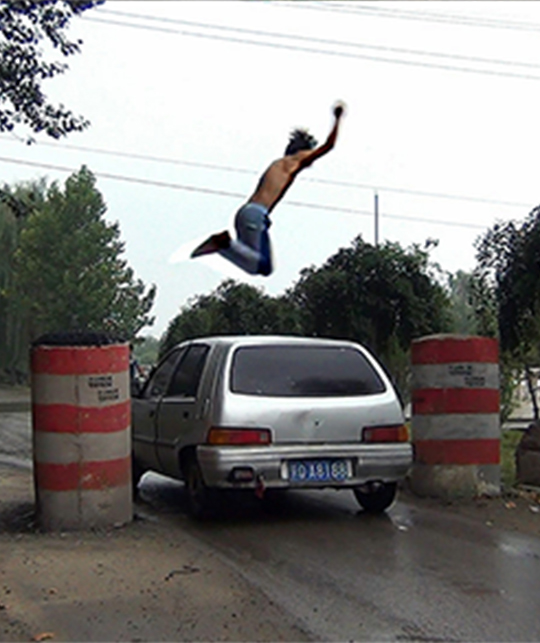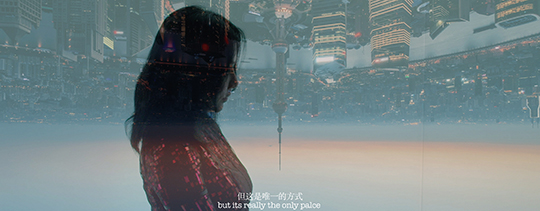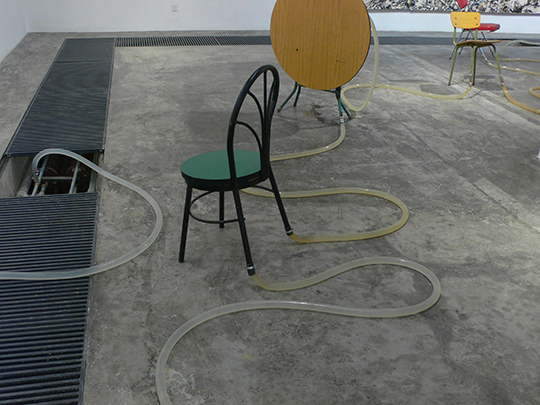THE RETURN OF CLASS: CONFRONTING THE SOCIAL NATURE OF ART
| January 6, 2016 | Post In LEAP 36

Chinese contemporary artists are a colorful bunch. They appear at openings and after-parties, deliberating on the latest gossip from Basel or Kassel. They live cosmopolitan lives, but they reside in humble studios in the Beijing suburbs of Heiqiao or Songzhuang, and are constantly facing eviction and rising prices. They can frequently be found, with a bottle of beer or a cup of tea, furiously arguing the merits of Rancière or Agamben’s most recent translation. They turn red with anger over disagreements about modern Chinese history, but quickly agree on their rejection of the most recent policies put forward by the Ministry of Culture. They interact with financial elites (large collectors), business owners and rentiers (small collectors), laborers (temporary employees), small business owners (gallery owners), white-collar workers (gallery employees), and rural entrepreneurs (studio landlords), but their own identity is some combination of plutocrat, small entrepreneur, government employee, freelancer, and craft artisan. However great the differences in their income levels, lifestyles, ideologies, social statuses, or professional and social circles, they all consider themselves first and foremost, contemporary artists.
The fact that artists are believed to cross or transcend class may be a historical repercussion of artists defining themselves as intellectuals. In the 1980s, all artists considered themselves to be intellectuals. In those years, anyone who graduated from university was an intellectual. Many works of art from the period aimed to provoke social response, which had yet to develop distinctions between high and low culture. Wealth was still only beginning to be accumulated in China during the 1980s, and, as a result, political and cultural capital were the main standards that defined social classes. Artists were cultural elites with high-level educations whose words had influence, so it was natural for them to define themselves as intellectuals.
Are intellectuals a social class? There is no consensus on the question. The officially recognized theory of the “primary stage of socialism” (shehui chuji jieduan lilun) holds that, following the implementation of China’s economic reforms, intellectuals are a part of the working class that can be distinguished from workers and peasants. In other words, intellectuals are understood to be cultural and technical workers who do not possess a means of production. However, under the current atmosphere of enlightened thinking, and especially given the revival of liberalism, intellectuals are more likely to regard themselves as unique from and independent of class labels, often seeing themselves as a group that transcends society and social class. This was certainly true for artists in 1980s. During the 85 New Wave movement, they not only saw themselves as enlightened individuals that transcended society, but also as social pioneers.

For artists of the 1990s, the status of enlightened individual or pioneer took a backseat to the roles of rebel and observer. Nevertheless, they continued to consider themselves a group set apart from society. They were what Karl Mannheim termed “free-floating” or “unattached,” and could not be analyzed as part of any specific social class. However, the ideal of the intellectual who transcends class—the ideal that so many artists identified with—is an illusion. Ultimately it was Wang Guangyi who asked, in those years, “How come [officially recognized artists] Hua Junwu and Wu Zuoren get to live in mansions and drive cars? Why don’t we get to?”. In Li Xianting’s opinion, even artists working in Political Pop and Cynical Realism belonged to “a tradition among Chinese intellectuals,” as if artists would lose their legitimacy if they were no longer considered intellectuals.
When we discuss class among artists, we must first acknowledge the sudden reemergence of social classes in Chinese society. Recently, the differences between classes have become clearer and more solidified. Now they have even begun to reproduce themselves. When the buzzword “second-generation wealth” (fuerdai) has almost become passé, can we still pretend the art world has not been influenced? Class is already having a broad influence on artists, especially those born in the 1990s who are gradually beginning their careers. There are unmistakable class differences in artists’ families, educational backgrounds, careers, opportunities to exhibit, and in the resources they have for their art. By comparison, these differences were minor for artists of the 1980s, or were due to specific local factors.
Two distinct classes of artists can be distinguished among younger generations of whether their professional education was in China or abroad, the amount of productive resources they possess (including the state of their studio, whether or not they have long-term assistants, and whether or not they have the resources to make large-scale works), and differences in certain preferences. For most artists, these differences are not determined or all-encompassing, but they are present in various aspects which, in total, create an observable contrast.
It is important to discuss how much impact these class differences have on artworks and artistic practices. On a fundamental level, the amount of resources the artist can commit to a work determines the scale of the work. The material expenses and teams required to complete large installations are cost-prohibitive for lower-class artists, unless they receive grants, the application process for which is another manifestation of class. Artists who lack resources lean towards low-cost art forms such as body-based performance art. There are many types of performance art, but body art is the least expensive because the body is a cost-free, renewable resource. The Latin roots of the word proletariat literally means “one who has only their offspring,” suggesting that the only means of production that the proletariat possesses is the body.

Many artists prefer body art not only due to limits imposed by economic status, but also because of a desire to separate and define the self based on class interests. In this view, body art is honest and direct. They don’t want to make convoluted intellectual art, and their use of the body takes on the strengthened significance of a personal pledge. For this reason, competing to be the most ruthless, especially in regard to one’s own body, has become a common strategy. Another aspect of this self-determination is a sense of disgust with abstract art in the gallery system, which they see as effete, middle-class art. This demonstrates the degree to which they emphasize their class interests, bringing with them an attitude of institutional critique. They fundamentally do not accept the position of their social class, and want to reverse social hierarchies.
In 2013, the neologism diaosi appeared to describe another class mentality. Diaosi originally referred to young men in the urban lower classes. It described men who lacked resources, sexual or otherwise, and included students who were born into low-income families and low-status white-collar workers. The fact that diaosi broke out on the Internet demonstrates the decentralized authority of Internet discourse. The word disrupted many traditional class distinctions. As a result, it quickly became a popular term that people of all classes used to belittle themselves, thereby gaining the sense of relief associated with self-disparagement.
For diaosi artists, the Internet is a realm of cost-free dissemination. This led to a merging of body art and social media dissemination in a new form of artistic practice. The distinctive features of web platforms influenced this practice; eye-catching visual styles and content with a short timeframe took center stage, and the ability to provoke Internet sensations became a new method of competing to be the most ruthless.
A separate group of “successful” (gaodashang) artists has marked a strong contrast to these diaosi artists. Based on their ongoing collaboration with galleries who show their work, they try as much as possible to make their work exquisite and refined. It is as if only those with specialized knowledge and distinguished taste could appreciate their art, just as only those who understand wine can discern its quality. Unlike the diaosi artists, who compete on who can be the most ruthless, successful artists compete by refining their knowledge and taste, and galleries participate by providing services such as the interpretation of this work. When diaosi artists acquire stable gallery representation and have a chance to rise in class, they gradually give up the extreme strategies they previously practiced. Instead, they begin holding solo exhibitions every two or three years and employ professional working methods.

The difference between these different classes of artists is not merely a product of whether or not an artist was successful. In other words, these divisions are not the result of professional progression, but, to a large extent, spur on the phenomenon. The earlier a young artist begins working in a “professional” mode, the faster he or she becomes “successful.” By contrast, the number of opportunities available to those working in a violent diaosi style remains small. Given this fact, we can understand the personal trajectories of many young artists simply by looking at the artist groups they form.
It seems cruel to categorize artists based on the influence of social class, and doing so easily overshadows the impact that individual differences can have. For example, a talented artist from a lower-class background will still have more opportunities for success than an uninspired artist from a wealthy family. However, we must recognize that this only holds for the current class differences, which have yet to be solidified. If the disparities continue to grow, studying art itself may become an important delineator of class, as it is in many other countries. Lower-class individuals may be completely barred from the entryways to becoming an artist, except under the name of outsider art. It is also possible—and in fact this process has already begun—that tales of success in contemporary art will turn the industry into a shortcut for social mobility and attract young people seeking to alter their social status.
In recent years, the inherent social nature of contemporary art has not appeared in discussions of art and society. These discussions act as if art is a pure container into which the addition of social content is defined as art “intervening” in society. By this logic, the artist is imagined to be a subject who transcends society, who is not confined by social relationships, and who can express public opinion from the position of the lowest common denominator. This is a very narrow conception of society. It has gotten to the point that just doing field research, particularly about the lower classes, is considered social practice, much like going to the countryside and collecting folk songs was considered immersing oneself in real life under the aesthetic regime of socialist realism.
Contemporary art is an elitist art form that constitutes but one level of culture within the structure of society, other portions of which including ink painting, academic realism, Dafen Village-style painting (art for the masses), and what survives of rural painting or folk art. Following the recent expansion of contemporary art as a system, contemporary art itself has begun to fragment. Artists have long disagreed about how art should be made, how it should be exhibited, whom it is for, and who should collect it. When answering these questions, it is impossible to avoid the influence of class. Emphasizing this fact does not imply desire a return to simple class determinism, but rather to remind us that contemporary artists are gradually being incorporated into the social body. Given that the entire chain of artistic practice is related to how social resources are allocated, society can no longer be considered a phenomenon outside of art; it must be seen as an intrinsic component of artistic practice.
(Translated by Orion Martin)


